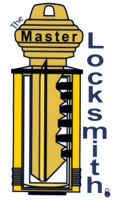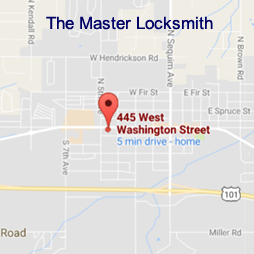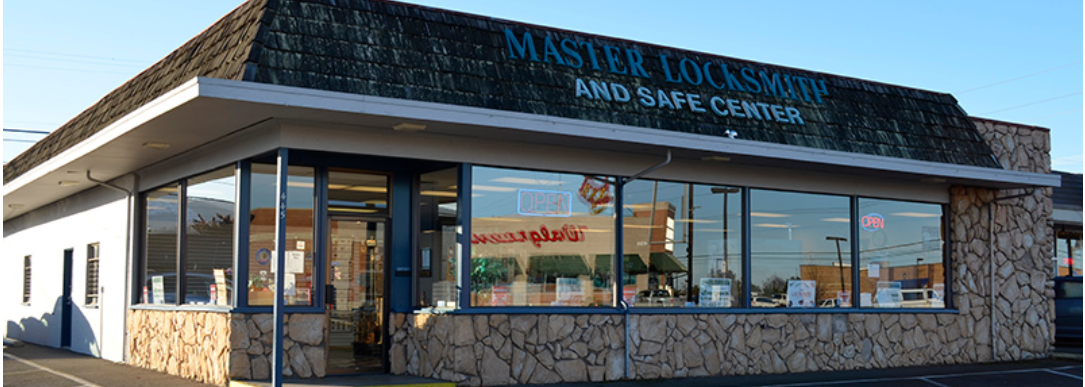The Master Locksmith
445 W. Washington Street
Sequim, WA 98382
"Experience Makes the Difference"
What to think about when purchasing a safe
When you are looking to purchase a safe, there are several things to consider:
1. How big of a safe do you need? One of the best ways to determine this is by figuring out what you want to put in the safe. Then taking a regular sized shoe box and putting those items into it; figuring out how many shoe boxes you will need to put in all the items. The inside of a safe is measured in cubic inches. This is a quick way to figure out how many cubic inches you are going to need.
2. What type of items are you going to be putting in the safe? Paper documents? Money? Jewelry? Coin collections? Guns? Are these items you need to get to daily? Or are you looking to put them some place where you can get to them when/if you need to?
3. Where are you going to put the safe? Are you looking to have a safe that no one can see? In the wall or in the ground? In a closet? Or is it something you don’t care if others know about?
Once you determine these factors you will have narrowed down the type of safe you are looking for.
Floor Safes: Using the term floor safe is a very generic way of asking for a safe. The reason for this is that most us (myself included) think of a floor safe in one of two ways. Either a safe that you put into the ground and surround with concrete or a safe that sits on the floor. In the industry, a floor safe is thought of as the first type. While the second type is just considered to be a “safe”.
Floor safes generally have lift off doors or use spring hinges to help raise the door for easy opening. These can be placed in various parts of the home. When using this type of safe, it is best to put your items into a zip-lock bag before placing them in the safe. If your home ever goes through a fire, when it is being hosed to put out the fire, the water will often seep into the safe. While your documents and items will be safe from the fire, they will not be safe from the water without taking the proper precautions.
The other [floor] safe often comes with bolt down hole so they can be bolted to the floor. This is to prevent someone from walking away with a safe that, if not bolted down, weighs less than 100 lbs. You can also add various option such as the safe being fire-proof, burglar proof or both fire and burglar proof. Note: Whenever a safe can have these options, it will always add to the price no matter the type of safe.
Wall Safes: I would think that every one would know what a wall safe is but just in case; a wall safe is a safe that is mounted into the wall. The depths of these safes range between 4″-15″ deep. As of this writing, I only know of one, made by AMSEC, that is fire-proof.
Gun Safes: These safes generally stand about 5′ tall and come in various width and depth dimensions. They come standard, fire-proof and burglary proof. They also come with various interior configurations; All shelves, half shelf/half gun/rifle and all gun/rifle. These different interiors allow you to make the most of your gun safe. They are also, generally, the most decorative of the bunch; so having a gun safe in your living room as part of the decor is not unheard of.
In some states (As an example in Washington state: RCW 82.08.832) you can purchase a gun safe tax-free. Washington State pass this as a way to encourage people to lock up their hand guns and rifles to prevent unauthorized use.
Safes also come with various ‘dial’ configurations. Most safes come with a dial or key combination lock; however you can get them with an electronic combination lock or fingerprint lock. As technology advances, so do state of the art dials. Any safe that offers the “choice” of the type of dial you have, also can have an addition to the purchase price of the safe.
There are several small safes out there as well. These can be referred to as microwave safes since they are about the size of a microwave. There is also a campus vault available for college students. These often come with electronic dials, bolt down holes and sometimes fire-proof that are available for minimal cost. (Ranging from $100 – $300).
So the big question is:
How much do you want to pay for a safe? Most people want a lot for nothing. In our current economy this is even more prevalent. Just remember you get what you pay for.
What you need to know about a ‘fire-proof’ or ‘fire-resistant’ safe:
1. ) What makes safe manufacturers different in there products are the type of materials they use for making the safe fire-proof and how much of it they use. [Gypsum or Sheetrock; Gypsum is the better choice.] How many ‘layers’ are used because when a fire burns each ‘layer’ releases water vapor to keep the interior cool.
2.) What is the U.L. fire rating? This rating states how long a safe must be able to stand a fire. A normal house fire burns at around 1200° We wouldn’t recommend a safe that can’t withstand a fire for at least an hour (AMSEC tests their safes at 1800°) should be the minimum that you purchase.
3.) What are burglary ratings?These are ratings based on the use of “regular” methods of someone working with a torch, drill, saws, pry bars, etc. in order to gain entry into the safe.
As you figure out the type of safe you need, based on the above information and narrow it down to what is best for you. There is one last thing to consider; whether to buy a safe or use a bank safe deposit box.
This is a lot like sorting out the benefits of rent or own. When you use a safe deposit box, you are renting it. You pay a monthly charge for the length of time that you have it. You also only have access to the box during regular bank hours. Whereas when you purchase a safe, you are paying out one (often times large) payment; but you have access to your valuables whenever you want.
If you are going to purchase a safe, we highly recommend AMSEC. They have a great product and are a leader in their industry. Unlike a lot of safe companies, they have always been a safe company. Many other companies started out making other things. They have a great product warranty and their staff is friendly and helpful.
Contact Us About Your Project TODAY!
 The Master Locksmith
The Master Locksmith
located at
445 W. Washington St.
Sequim, WA 98382

(360) 683-8817
Serving the Communities of the
North Olympic Peninsula
in Washington State:
Sequim
Carlsborg
Port Angeles
Port Townsend
and surrounding communities
